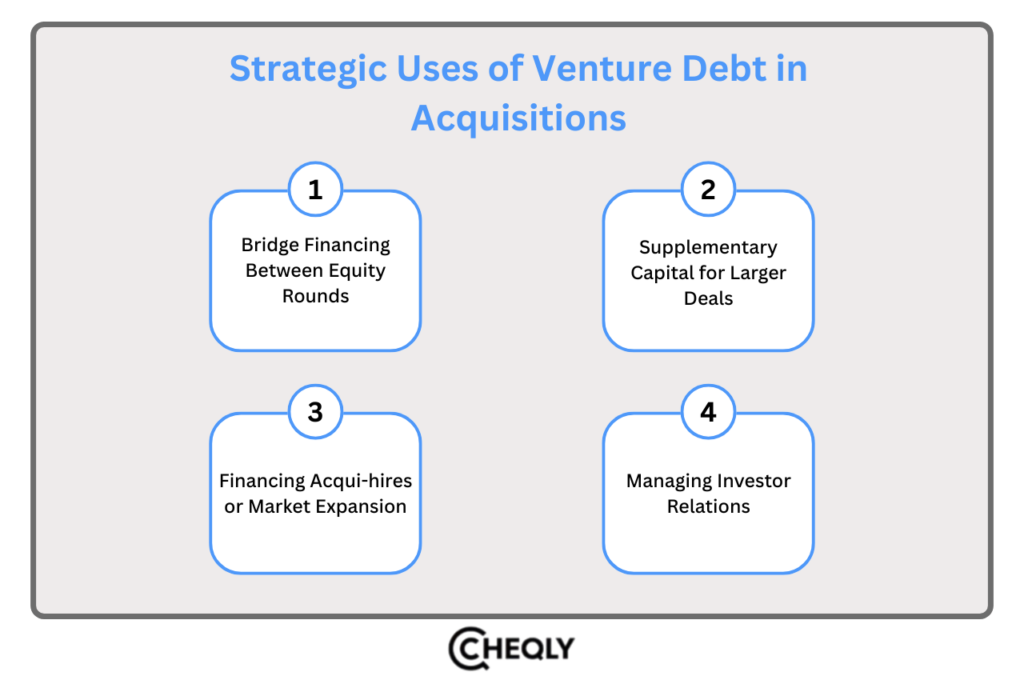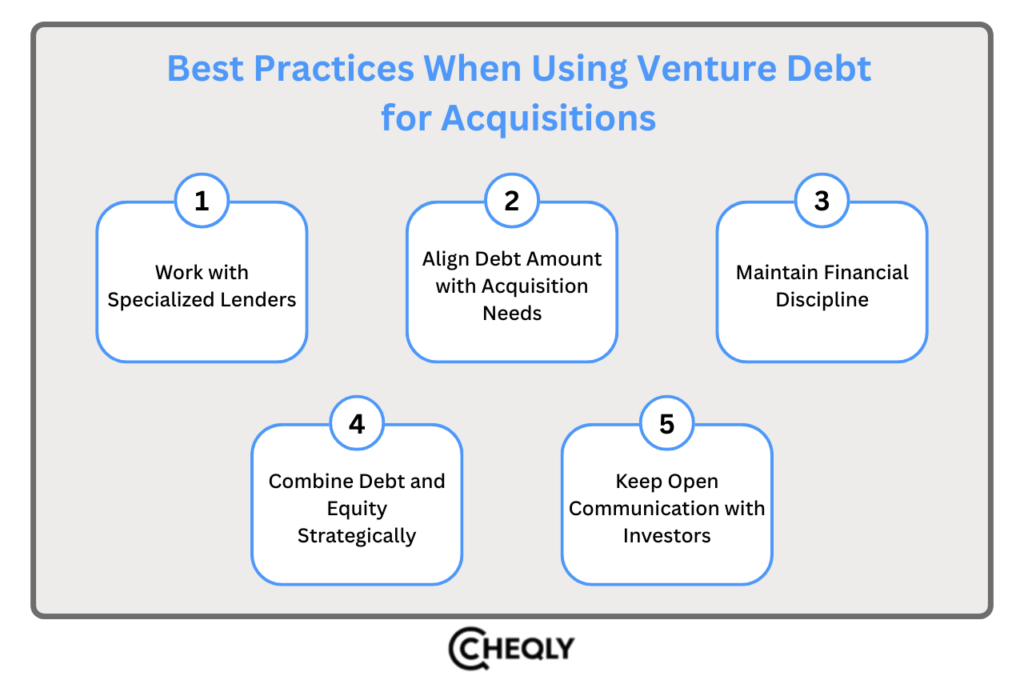Startups and high-growth companies in the US have changed their views on the capital-raising process to maintain their pace and remain competitive in the market. Although equity rounds are still recognized as a standard option, the majority of founders are looking for financing that helps the company grow without losing ownership. Venture debt is gaining popularity as a non-dilutive alternative that gives startups the financial strength to extend their cash runway, pursue strategic acquisitions, and accelerate growth, while at the same time maintaining control over their business.
In this article, we break down how venture debt fuels strategic acquisitions, examining its key benefits and hurdles, and offering founders ways to leverage it for growth.
Understanding Venture Debt
Venture debt is designed for fast-growing startups, especially those that have recently raised institutional venture capital, are typically backed by strong investors, demonstrate consistent annual recurring revenue (ARR) traction, maintain a clean capital structure, and have little or no outstanding bank debt. Instead of focusing on past revenues, lenders look at the company’s future potential and the size of its last equity round, typically offering between 25% and 35% of that amount. While it is still a loan that must be repaid, venture debt gives founders access to capital without giving up a significant share of ownership.
Some lenders may demand warrants (or rights to buy shares in the future), but the effects on ownership are likely to be much weaker than an equity round, and thus warrant a strong consideration by applicants who are interested primarily in control.
Why Venture Debt Is Well-Suited for Strategic Acquisitions
Startups can achieve significant growth through smart acquisitions, gaining access to new technologies, customers, and markets. When timing is critical, venture debt allows founders to execute such deals quickly and efficiently—without sacrificing a large portion of their ownership. As a result, it becomes a decisive advantage in high-growth sectors.
Equity Preservation During Acquisitions
Startups can use it to obtain the capital needed for acquisitions while still preserving founder or investor ownership. Unlike equity rounds that dilute ownership—and thus control—expansion with this option keeps business owners satisfied, making it a strong option for rapidly growing companies with limited resources.
Flexible Financing Options
This financing option can come in different forms; for example, it can be a term loan, a revolving credit facility, or even a specific repayment plan that is suitable for a particular business’s acquisition needs. Debt providers in the venture sector have the flexibility to adjust the size of the fund and how it is allocated in accordance with the company’s cash flow and the timing of the transaction, satisfying the requirements of both pre-acquisition and post-acquisition.
Enabling Combined Growth
In many cases, mergers and acquisitions require a substantial sum that the company could otherwise use for its internal development. Startups can use venture debt to back M&A activities and keep the rest of the money for product development, hiring, or market growth. Such adaptability makes it possible to grow not only through the company’s own resources but also through acquisitions, which means that founders can accelerate their businesses more effectively while still staying true to their purpose and pace.
Cost Efficiency & Tax Benefits
On the whole, venture debt can save more money than issuing new equity, making it instrumental in reducing overall acquisition expenses. However, the real cost varies depending on the company’s growth potential and risk. Additionally, the firm can deduct the interest paid on the loan from its taxes, creating another layer of economic efficiency.
Runway Extension
It allows a company to access additional funds, which can be used to maintain existing operations and growth, thereby extending the financial runway after a deal has been closed.
Strategic Uses of Venture Debt in Acquisitions
Venture debt, unlike equity, provides companies with financing that preserves control while still allowing them to carry out acquisition operations. Here are the strategic ways startups can use venture debt to support their M&A strategy.

Bridge Financing Between Equity Rounds
Startups frequently face attractive merger opportunities between planned equity fundraises. This financing can be seen as a bridge that helps companies finance the acquisition without jumping to a new equity round that can be on off-the-shelf terms. By leveraging debt instead of issuing new shares, companies avoid immediate dilution, giving them time to realize post-acquisition synergies and improve their valuation before the next fundraise.
Supplementary Capital for Larger Deals
In the case of larger acquisitions, it may be combined with equity investment to raise available capital. This two-pronged strategy makes startups able to do bigger, more transformative deals without over-diluting them. It also facilitates a stronger balance sheet and proves a point to the current and potential investors that the company is utilizing capital in an effective and strategic manner.
Financing Acqui-hires or Market Expansion
Speed is crucial when acquiring top talent (acqui-hires) or entering new markets. It provides the rapid deployable capital required for these fast-turnaround opportunities, enabling startups to act decisively. Its non-dilutive nature also lets founders make these moves without lengthy fundraising distractions or giving up additional control.
Managing Investor Relations
Using venture debt to finance acquisitions helps companies negotiate from a position of strength in future equity rounds. Reducing the frequency and urgency of equity raises gives founders more leverage with investors, allowing for more favorable terms and outcomes. It also signals prudent capital management and growth discipline to the investor community.
Venture Debt Example — SaaS Acquisition
Imagine CloudSync, a Series B SaaS company with stable recurring revenue, looking to acquire a smaller competitor with complementary technology. Rather than raising equity, the company opts for a $10 million venture debt facility with a three-year maturity and interest-only first year.
As a result, CloudSync can:
- Carry out the acquisition effectively.
- Maintain founders’ ownership and control.
- Combine the target team while ensuring a smooth flow of working capital.
- Grow the company’s presence in untapped markets and enhance monthly recurring revenue.
- Be better prepared for a higher Series C valuation.
Risks and Considerations
Although venture debt is quite appealing to companies, they should thoroughly assess:
- Repayment Obligations: A business that is in debt will have to repay it within a fixed time frame, whether or not the business is doing well. This may result in cash flow problems following a takeover.
- Higher Interest Rates and Warrants: Startups taking this financing option should expect higher interest rates than regular loans, along with the possibility of warrants that cause indirect dilution.
- Eligibility Requirements: Venture debt lenders generally expect a strong venture capital source, clear growth numbers, and no prior debt.
- Market and Economic Conditions: Credit availability, in addition to cost, may differ due to the general market situation that influences the terms and the practicality of the transaction.
Best Practices When Using Venture Debt for Acquisitions
You can use venture debt to finance an acquisition, which can be a very powerful tool. However, the use of such a tool requires careful planning. The following are some best practices to consider:

- Work with Specialized Lenders: Work with venture debt providers who have experience in acquisition finance and are familiar with industry dynamics and deal timelines.
- Align Debt Amount with Acquisition Needs: Calculate the total capital needed beyond just the purchase price. Include integration expenses, post-acquisition working capital, and reserve buffers.
- Maintain Financial Discipline: Build realistic cash flow projections that ensure debt obligations are met while supporting steady business growth.
- Combine Debt and Equity Strategically: Use this financing alongside equity rounds as a complement to maximize ownership, reduce cost, and increase flexibility.
- Keep Open Communication with Investors: Make sure that both equity and debt shareholders are on the same page with the acquisition strategy and growth plans.
Takeaway: Venture debt is a powerful, non-dilutive financing tool for acquisitions, but its benefits come with repayment obligations and eligibility barriers. Used thoughtfully, it allows startups to pursue M&A that accelerates growth, preserves founders’ ownership, and intelligently complements equity financing.
Venture Debt for Acquisitions: FAQs
Getting familiar with common questions around venture debt can help founders understand this option better and use it more confidently.
Can I combine equity and venture debt for an acquisition?
Yes, combining equity and venture debt is common. It supplements equity to reduce dilution and optimize capital structure while providing flexibility for acquisition needs.
Do all lenders require warrants?
Warrants are commonly included by most venture debt lenders, even if limited in size. They give the lenders the right to purchase equity later, leading to some dilution over time.
How do venture lenders evaluate an acquisition deal?
Lenders measure the startup’s growth potential, latest equity backing, acquisition synergies, cash flow projections, and repayment capacity before giving the green light to debt for acquisitions.
How do I find the right venture debt partner?
Search for lenders who have industry-specific knowledge, a history of successful acquisitions, adaptable terms, and are open to working with you on your growth plan.
How does venture debt differ from equity financing?
It is required to be repaid with interest and usually entails smaller ownership dilution. On the other hand, equity financing means the company sells a part of its ownership and, hence, has no repayment obligations.
What are the key terms to watch in a venture debt term sheet?
Key terms include interest rates, repayment schedule, warrant coverage, covenants, loan amount, maturity period, and default conditions.
Can a venture debt fund make international acquisitions?
Yes, it can be used for international acquisitions if lenders are comfortable with the risks and the startup demonstrates strong cross-border capabilities.
How long does it take to close a venture debt deal for acquisition?
Generally, it is finalized more quickly than equity, i.e., most of the time in a matter of weeks, but the exact period depends on the intricacy of the deal and the amount of due diligence required.
Drive Strategic Growth Through Venture Debt with Cheqly
Venture debt is a type of financing that doesn’t dilute ownership and helps startups grow strategically. It can fund acquisitions, business expansion, or extend the company’s runway. However, lenders often set rules on how the money can be used—like working capital, capital expenditures, or specific approved acquisitions—so founders need to plan carefully while keeping control of their company.
Startups in need of flexible financing can look to Cheqly. Along with tailored venture debt solutions, Cheqly provides everyday financial tools like business accounts, physical and virtual debit cards, ACH payments, and wire transfers. This way, founders get the capital they need to grow while also simplifying daily financial management and keeping working capital under control.
Through intelligent structuring and adequate preparation, this financing option opens up M&A opportunities that lead to business expansion while maintaining founder ownership.
Start with Cheqly and check if you’re eligible for venture debt to support key acquisitions and accelerate your strategic growth.
